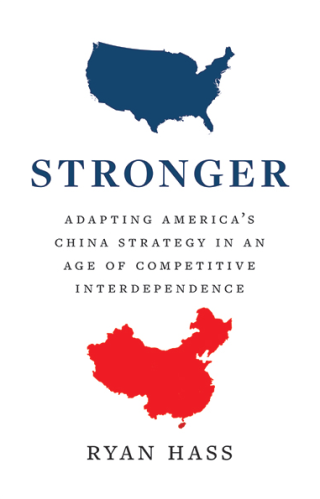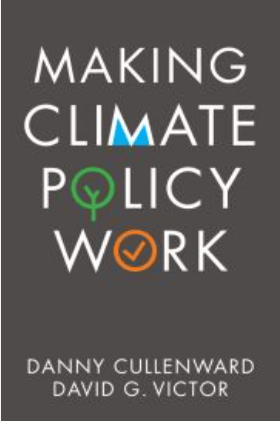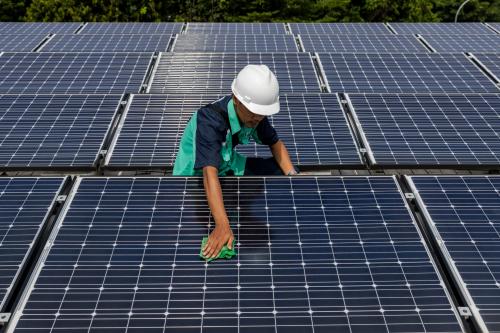What a difference a decade makes. Ten years ago, during the runup to what became the Paris Agreement, it was cooperation between the United States and China that largely set the direction for global efforts on climate change. The two countries funded joint research projects and exchanged best practices with regulators and academics. Most visibly, in 2014, just a year before the Paris Agreement was adopted, U.S. President Barack Obama and Chinese President Xi Jinping held a summit in Beijing at which the two nations pledged to each other the actions they would take. That pledging approach is a centerpiece of the Paris Agreement — today, nearly every country on the planet has a pledge, and most have updated them to reflect new efforts.
Today that cooperation is gone. The only high profile actions between the world’s two most powerful nations seem to involve acrimony and disagreement, like the angry confrontations in March when U.S. and Chinese officials met in Alaska to take stock of their relationship or the repeated efforts by U.S. officials, including Special Presidential Envoy for Climate John Kerry, to get China to commit to more climate action. There are hints that quiet diplomacy is making a bit more headway — it usually does, especially when diplomats need to signal to interest groups at home that they are being tough — but the toxicity between the nations is palpable. For the U.S., the road to climate cooperation no longer runs through Beijing. And it doesn’t help that the U.S. itself is having a hard time putting together its own credible plan for emissions control.
All of this is terrible news for serious action on climate change, but what can be done? In this month’s edition of Issues in Science and Technology, the magazine of the U.S. National Academy of Sciences, I offer some answers in an essay co-written with Valerie J. Karplus and M. Granger Morgan. Our interest is in finding places where the two powerhouses in science and technology can cooperate — a big agenda that includes much of what is most important for progress on climate change.
Although less visible than cooperation on topics like arms control and trade agreements, science and technology is the centerpiece to making progress on topics like climate change. That’s because deep cuts in emissions are impractical without a lot of new technology. And while the whole world benefits from that technology, progress in just a handful of markets defines the global technological frontier. With only a few places that matter most, cooperation in principle should be much easier when compared with efforts to forge global agreements that require consensus from nearly every nation. (The 2021 United Nations Climate Change Conference or COP26 taking place in Glasgow over the next two weeks will put a spotlight on those global efforts; even for agreements with little content, progress will be slow). And for both China and the U.S., the benefits from successful science and technology cooperation are palpable and huge. These benefits are important incentives because in these times any effort to cooperate — no matter how worthy — will face political headwinds.
To assess the potential for cooperation on various issues in science and technology, Valerie, Granger and I outlined a framework that works in two dimensions, as shown below. Along one dimension are the joint gains from cooperation. Places where both nations have comparable skills and operate at the frontier offer the greatest prospects. Along the other dimension are the political risks. Many areas where cooperative gains could be huge — whether joint investigation on the origins of COVID-19 or technologies known as “geoengineering” that might let us manipulate the climate directly if warming gets out of control — are politically toxic not just bilaterally but also in how they create suspicions for important U.S. allies.

The trick is to pick and choose — and the more the U.S.-China relationship deteriorates overall, the more choosy the architects of cooperative arrangements must become. The good news is that there are many topics in the low-political risk, high-social gains sweet spot that could advance the climate for cooperation. One is the testing and deployment of carbon capture and storage (CCS) technologies that would make it possible to keep using some fossil fuels while capturing and safely disposing of the carbon pollution that all fossil fuels make when burned. There is a long record of failure with CCS — not because the idea is technologically flawed but because we lack much real world experience with large scale CCS projects that can test a variety of approaches. Joint demonstrations and learning could help commercialize and scale CCS — and other new technologies — faster than either country would on its own. As the U.S. struggles to cut its emissions, it would benefit directly from a more viable CCS industry — along with other low carbon industries such as those that will emerge with demonstration of the next generation of nuclear reactors.
New technologies are important because they open new industrial and business opportunities for cutting emissions. When solar panels got cheap, for example, more countries adopted them. Interest groups that previously saw disruption and cost in the new industry were refocused on the gains from bigger market shares for solar. Politics that had been nasty, brutish, and gridlocked opened up. In industry after industry the same story repeats — technology changes politics, and cooperation changes technology faster.
A strategic approach to science and technology cooperation won’t stop climate warming by itself, but it is a necessary condition. And success offers something important for the two countries beyond making progress on joint problems like climate change: a way to cooperate on practical topics when broader cooperation is impractical. During the Cold War, the U.S. set up a similar technical cooperative approach with the Soviet Union — creating an invaluable community of experts on both sides of the Iron Curtain that made it possible to keep talking even when top government leaders couldn’t. I went to graduate school just as the Cold War ended and one of my most formative experiences was working alongside Soviet scientists at one of those curtain-crossing institutions, the International Institute for Applied Systems Analysis in Vienna.
In an earlier era, before the unraveling of the last decade, U.S. and Chinese scientists could cooperate because it was easy. Ideas abounded. Partnerships flourished not only because there were gains but also because many of the key scientists knew each other — many of the key Chinese academics were, in fact, educated in the United States.
Today, cooperation is perhaps even more important but harder. (That so much Chinese education is leaving the U.S., and that both sides are vilifying each other, are bad news for our long-term cooperative prospects). The U.S. and China have both promised the world they’ll do something serious about climate change. Both now face the world’s ire for not doing enough. Strategic cooperation around the topics where cooperation is possible and useful is a way forward.
While it is unfashionable to be a globalist these days, when it comes to the technology revolutions needed for deep decarbonization, a large dose of globalism is essential. The great visions for new technologies to address climate change are based on the opportunity for technological advance through collaboration and economic improvement through scaling to global markets. That’s how solar got cheap and global. And that’s the same story now playing out in many other technologies, from electric vehicles to electrolyzers that make hydrogen, possibly one of the fuels of a clean energy future. It all starts with globalism in technology and with the two biggest players — the U.S. and China.
The Brookings Institution is committed to quality, independence, and impact.
We are supported by a diverse array of funders. In line with our values and policies, each Brookings publication represents the sole views of its author(s).










Commentary
Rebuilding US-Chinese cooperation on climate change: The science and technology opportunity
October 28, 2021